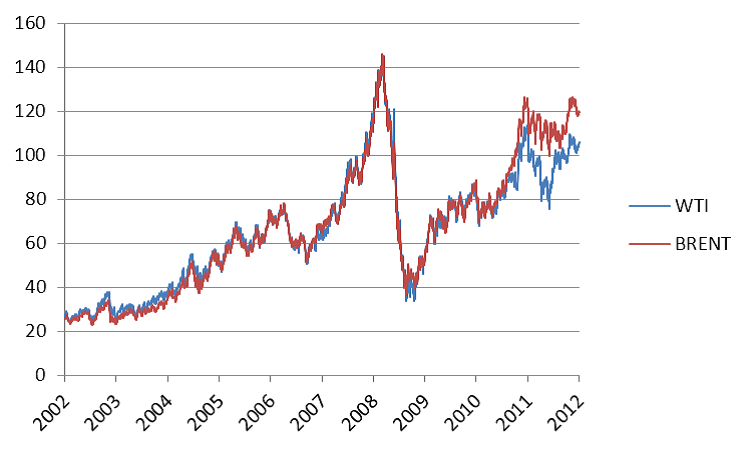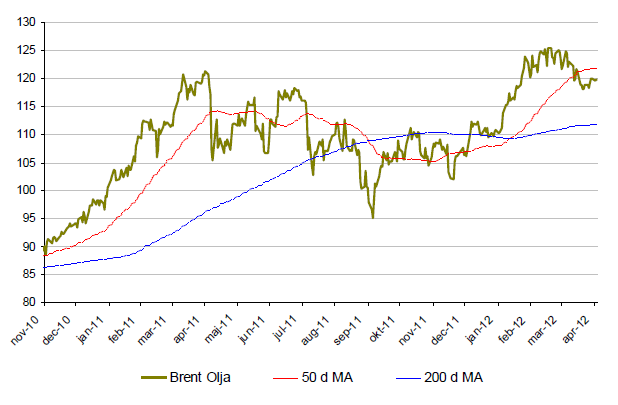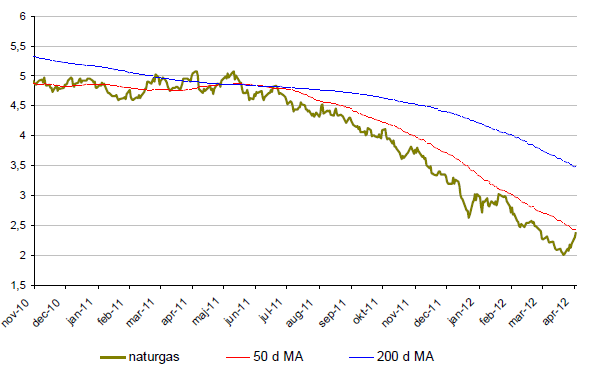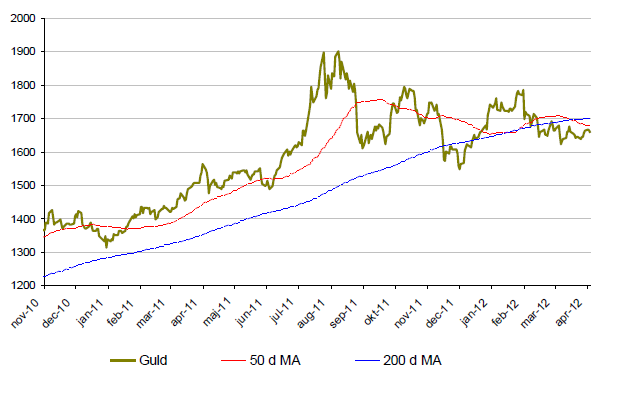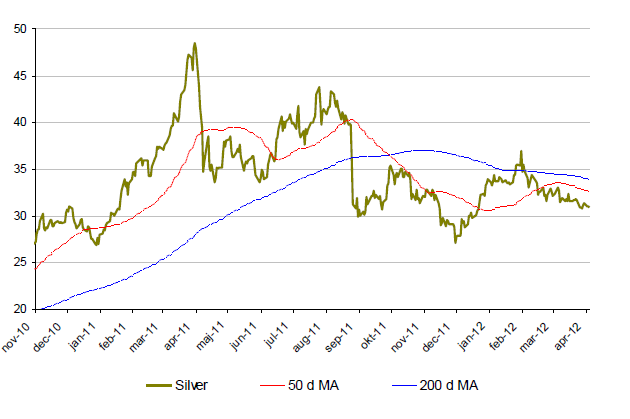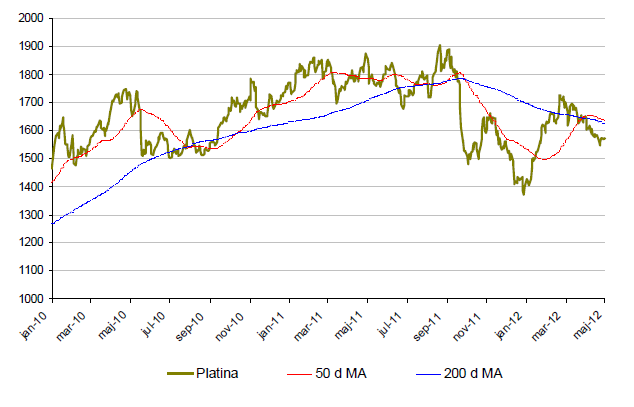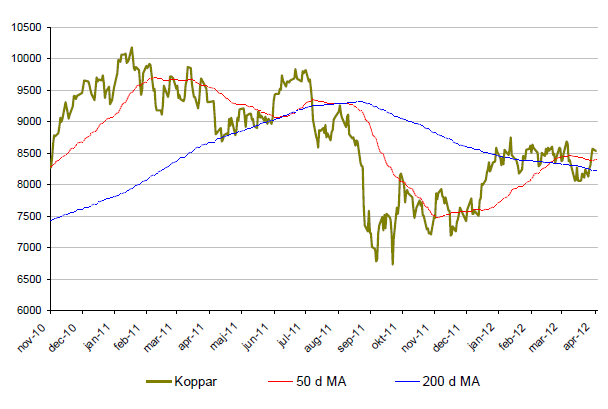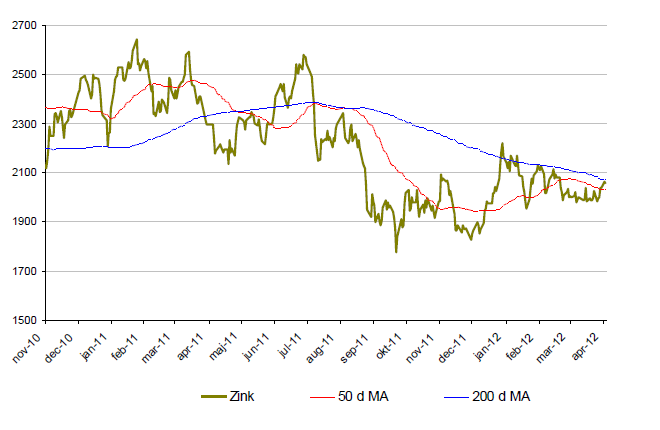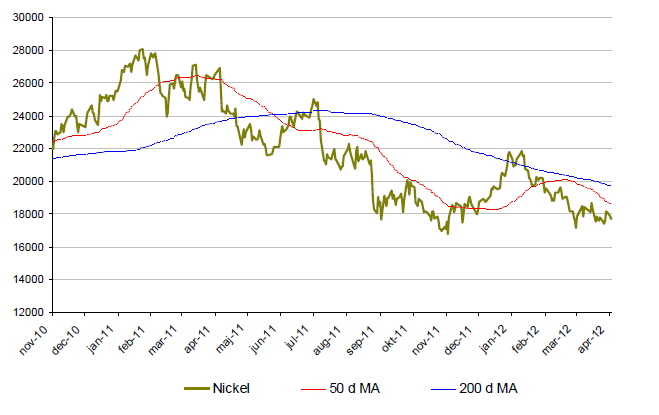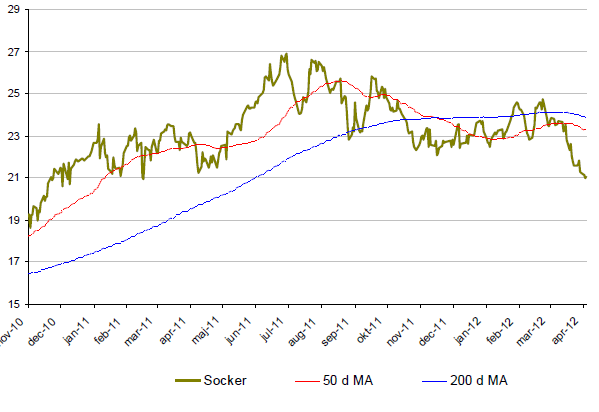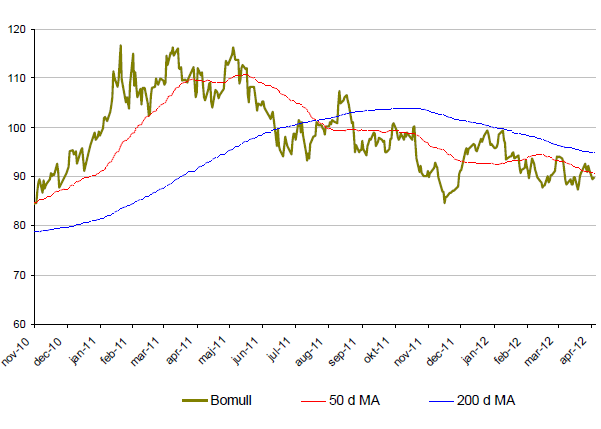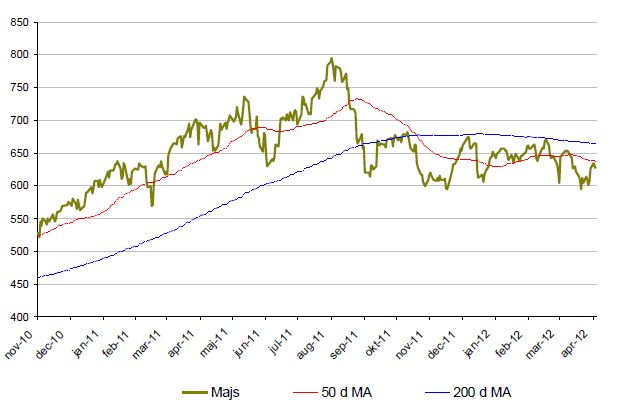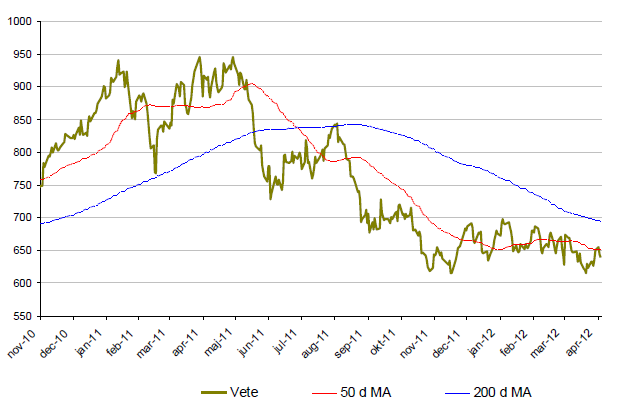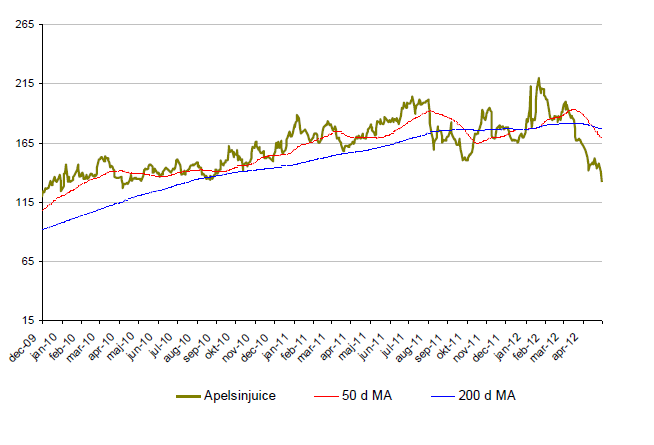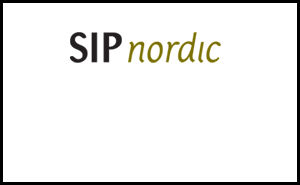Analys
SIP Nordic – Råvaruguiden – maj 2012
 Söta, lätta och lika svarta – ändå så olika
Söta, lätta och lika svarta – ändå så olika
När medier rapporterar om oljepriset säger de oftast just olja. Vad de missar är att det finns över 160 olika oljesorter som handlas på olika råvarumarknader. Nu är det ju självklart så att vi vanliga spekulanter inte kan investera i alla dessa 160 oljetyper. Vi har vanligtvis två val. WTI-oljan eller Brent-oljan. De är båda svarta till färgen, kallas söta och lätta men priset skiljer sig nu mer än vanligt.
Vad som skiljer de olika oljetyperna åt och som till stor del genererar prisskillnaderna mellan dessa är dess egenskaper och kvalité. Olja med bättre kvalité bör under normala marknadsförhållanden kosta mer än den med sämre kvalité.
WTI och Brent vanligast
 De två mest handlade oljetyperna är WTI- och Brent-oljan. Båda WTI och Brent är med sina relativt låga densiteter så kallade lätta (light) oljor. WTI är något lättare än Brent. Dessutom är svavelnivåerna i oljorna lägre än 0,5 % vilket klassificerar dem som söta (sweet). Återigen är WTI- oljan något bättre än Brent-oljan även i detta avseende.
De två mest handlade oljetyperna är WTI- och Brent-oljan. Båda WTI och Brent är med sina relativt låga densiteter så kallade lätta (light) oljor. WTI är något lättare än Brent. Dessutom är svavelnivåerna i oljorna lägre än 0,5 % vilket klassificerar dem som söta (sweet). Återigen är WTI- oljan något bättre än Brent-oljan även i detta avseende.
Dessa två egenskaper gör att WTI-oljan anses vara av bättre kvalité än Brent-oljan. Historiskt sett handlas även WTI-oljan till ett högre pris än Brent-oljan. De senaste åren handlas dock Brent-oljan till ett högre pris än WTI-oljan.
Ökade lager i USA och oroligheter i mellanöstern
Priset på WTI-oljan, som framförallt raffineras i USA och den mexikanska golfen, reflekteras ofta i tillgångs- och efterfrågebalansen på den amerikanska och kanadensiska marknaden. Brent-oljan, som är en kombination av olika oljor från 15 olika oljefält i Nordsjön, tenderar å andra sidan att styras mer av den globala tillgångs- och efterfrågebalansen. Dessutom tenderar Brent att påverkas mer av de oroligheterna vi sett i mellanöstern den senaste tiden.
WTI-oljan har historiskt sett handlats runt $2 dyrare än Brent. Det senaste tidens oroligheter i mellanöstern och ökade lagerstatistik i USA har dock resulterat i att Brent-oljan kostat så mycket som $25 dollar mer än WTI.
Råvaror – Energi
Brent olja
- Olja är upp ca.11 % upp för året.
- Under april månad har dock Brent-oljan tappat 3 %.
- Det finns idag ingen riktigt tydlig kortsiktig riktning för Brent-oljan. Upp på längre sikt.
- Lagernivåerna spås öka under Q2, dock från låga nivåer vilket är en följd av ökad produktion från OPEC-länderna och säsongsrelaterade minskningar i efterfrågan.
- Trots detta kan priset på olja fortsätta ligga på dessa nivåer till följd av att OPEC-ländernas produktion används för att täcka bortfall av Iransk olja.
Naturgas
- Naturgas har under april månad utvecklats väl. För månaden upp ca 6 %.
- Sista veckan i april gick naturgas upp över 20 %.
- Trots detta ligger naturgas på historiskt låga nivåer.
- Varma temperaturer i framförallt USA bidrar till minskad efterfrågan vilket har påverkat priset negativt under året.
- Lagren av naturgas väntas öka under 26 %.
- Priset är nu så pass lågt att producenter kan tvingas minska produktionen. Ett sådant stopp kan få priset att studsa upp.
Råvaror – Metaller
Guld
- Guld har under april månad tappat ca en halv procent. För året är guld upp 7 %
- Reuters publicerade i april sin guldundersökning. Där förutspås en guldkurs som fluktuerar i ett stort spann men som ligger något över dagens nivåer vid årets slut.
- I undersökningen tas det även upp att centralbankerna fortsätter att öka sitt guldinnehav under 2012. De justerar även den tidigare prognosen om 300 ton nettoinflöde till 400 ton.
- Det skrivs också om fallande guldpriser under 2013 till följd av stabilare globalt marknadsläge.
Silver
- Silver har i år gått upp med ca 15 %. Under april månad har dock priset på silver backat med ca 5 %
- Silver befinner sig fortsatt i en långsiktigt fallande kil.
- Tillgången på silver väntas minska med 1,5 % samtidigt som efterfrågan endast spås öka med 0,3 %. Trots detta är tillgången på silver god.
- Den europiska kreditkrisen i kombination med rädsla för minskad kinesisk tillväxt bidrar till de negativa sentimenten i silver.
Platina
- För året är platina upp ca 13,5%.
- Under april månad har platina tappat 4,7 %
- Nedgången gör att platina nu återigen handlas till en billigare kurs än guld.
- Platinatillgången spås öka med 3 % under 2012 samtidigt som konsumtionen endast väntas öka med 2 %. Detta gör att skillnaden mellan tillgång och efterfrågan väntas öka med ca 12 %.
- Rädsla för en fördjupad europeisk kris i kombination med en rädsla för mindre kinesisk tillväxt pressar platinapriset.
Koppar
- Koppar har börjat året starkt efter ett ur svagt 2011. Koppar har gått upp ca 12,5% i år. (Att jämföra med -21 % under 2011)
- Under april månad har dock kopparpriset stagnerat och är upp 0,5 %.
- Siffror visar att världens största konsument av koppar, Kina, under mars månad importerade över 480 tusen ton. Den fjärde högsta siffran någonsin.
- Kopparinventarierna ligger på låga nivåer och lagren av koppar räcker endast i tre veckor.
- Samma siffra väntas sjunka till 2.8 under 2013 vilket kan pressa kopparpriset trots rädsla för en avsvalnad kinesisk tillväxt.
Zink
- Likt koppar har zinkpriset kraftigt stigit under den första månaden av 2012. Zink är upp ca 11 % för året.
- Zinkprisets har trots en mer sund balans i tillgång och efterfrågan gått upp ca 1,5 % under april månad.
- Den årliga konsumtionen av zink förväntas växa med 3.6% samtidigt som tillgången bara förväntas växa med 3 %. Det uppskattas dock att nuvarande zinktillgång skulle räcka 7,5 veckor, 0,5 veckor längre än 2011.
Nickel
- Nickel presterade sämst av alla basmetaller under 2011.
- Nickel fortsätter sin kräftgång under 2012. Efter en uppgång i januari tappade nickel närmare 18 % under februari och mars och är nu den enda basmetallen som inte utvecklats positivt under 2012.
- Produktionen väntas överstiga konsumtionen under 2012. Mängden tillgänglig nickel väntas dock minska under 2013 och i kombination med ett bättre marknadsläge spår analytikerna ett högre nickelpris under 2013.
- Nuvarande nickelnivåer räcker för 10,4 veckors konsumtion. Ca en vecka högre än 2011.
Råvaror – Jordbruk
Socker
- Socker startade året starkt till följd av dåliga och torra väderförhållandena i världens största sockerproducerande land, Brasilien.
- Sedan mars faller dock socker kraftigt. Indien producerar och exporterar socker i hög fart vilket resulterat i att socker under mars-april tappat nästan 16 %.
- Genomsnittspositionen är fortsatt lång men säljarna börjar nu bli fler och fler.
Bomull
- Bomull är för året ned ca 4 %
- Under 2012 har säljarna kopplat greppet om bomull.
- Exporten från Indien väntas öka under året. Dessutom visar siffror att produktionen av bomull i USA väntas vara högre än beräknat.
- Den kinesiska efterfrågan på bomull har under april månad avtagit.
Majs
- Majspriset är i stort sett oförändrat för året. (+1%)
- Majs pendlar mellan 600 och 660 cents.
- Väderförhållanden i USA är goda inför den majs som sättas och skördas under våren.
- Statistik som visar USA-exporten av majs ökar kraftigt. Kina importerar nu rekordstora mängder majs.
- En ökad efterfrågan neutraliseras av goda väderförhållanden vilket gör att det inte finns en tydlig trend i majs.
Vete
- Antalet spekulanter som tror på nedgång fortsätter att växa.
- För året är vete i det närmaste oförändrat.
- Priset pendlar nu mellan 620 och 660.
- Anledningen till att vetekursen konsoliderar är att USDAs lagerstatistik om ökade lager neutraliseras av dåliga väderförhållanden i östeuropeiska länder.
Apelsinjuice
- Priset på apelsinjuice fortsätter att falla som en sten.
- Sedan toppen den 19 januari har apelsinjuice nu tappat över 30 %.
- Det finns fortfarande fallhöjd i kursen då apelsinjuice har stigit med nästan 113 % sedan 2009.
- Skörden spås dock bli väldigt god i Florida samtidigt som rapporter visar att efterfrågan på apelsinjuice minskar vilken kyler av priset.
- Skörden för året spås bli mycket högre än förra året.
[box]Denna uppdatering är producerat av SIP Nordic och publiceras i samarbete och med tillstånd på Råvarumarknaden.se[/box]
Ansvarsbegränsning
Detta produktblad utgör endast marknadsföring och har sammanställts av SIP Nordic Fondkommission AB.
Innehållet ger inte fullständig information avseende det finansiella instrumentet. Investerare uppmanas att del av prospekt och slutliga villkor, vilka finns tillgängliga på: www.rbsbank.se/markets, innan ett investeringsbeslut tas.
Förekommande exempel är simulerade och baseras på SIP Nordics egna beräkningar och antaganden, en person som använder andra data eller antaganden kan nå andra resultat. Administrativa avgifter och transaktionsavgifter påverkar den faktiska avkastningen.
Analys
Crude oil soon coming to a port near you

Rebounding along with most markets. But concerns over solidity of Gaza peace may also contribute. Brent crude fell 0.8% yesterday to $61.91/b and its lowest close since May this year. This morning it is bouncing up 0.9% to $62.5/b along with a softer USD amid positive sentiment with both equities and industrial metals moving higher. Concerns that the peace in Gaza may be less solid than what one might hope for also yields some support to Brent. Bets on tech stocks are rebounding, defying fears of trade war. Money moving back into markets. Gold continues upwards its strong trend and a softer dollar helps it higher today as well.

US crude & products probably rose 5.6 mb last week (API) versus a normal seasonal decline of 2.4 mb. The US API last night partial and thus indicative data for US oil inventories. Their data indicates that US crude stocks rose 7.4 mb last week, gasoline stocks rose 3.0 mb while Distillate stocks fell 4.8 mb. Altogether an increase in commercial crude and product stocks of 5.6 mb. Commercial US crude and product stocks normally decline by 2.4 mb this time of year. So seasonally adjusted the US inventories rose 8 mb last week according to the indicative numbers by the API. That is a lot. Also, the counter seasonal trend of rising stocks versus normally declining stocks this time of year looks on a solid pace of continuation. If the API is correct then total US crude and product stocks would stand 41 mb higher than one year ago and 6 mb higher than the 2015-19 average. And if we combine this with our knowledge of a sharp increase in production and exports by OPEC(+) and a large increase in oil at sea, then the current trend in US oil inventories looks set to continue. So higher stocks and lower crude oil prices until OPEC(+) switch to cuts. Actual US oil inventory data today at 18:00 CET.
US commercial crude and product stocks rising to 1293 mb in week 41 if last nights indicative numbers from API are correct.

Crude oil soon coming to a port near you. OPEC has lifted production sharply higher this autumn. At the same time demand for oil in the Middle-East has fallen as we have moved out of summer heat and crude oil burn for power for air-conditioning. The Middle-East oil producers have thus been able to lift exports higher on both accounts. Crude oil and condensates on water has shot up by 177 mb since mid-August. This oil is now on its way to ports around the world. And when they arrive, it will likely help to lift stocks onshore higher. That is probably when we will lose the last bit of front-end backwardation the the crude oil curves. That will help to drive the front-month Brent crude oil price down to the $60/b line and revisit the high $50ies/b. Then the eyes will be all back on OPEC+ when they meet in early November and then again in early December.
Crude oil and condensates at sea have moved straight up by 177 mb since mid-August as OPEC(+) has produced more, consumed less and exported more.

Analys
The Mid-East anchor dragging crude oil lower

When it starts to move lower it moves rather quickly. Gaza, China, IEA. Brent crude is down 2.1% today to $62/b after having traded as high as $66.58/b last Thursday and above $70/b in late September. The sell-off follows the truce/peace in Gaze, a flareup in US-China trade and yet another bearish oil outlook from the IEA.

A lasting peace in Gaze could drive crude oil at sea to onshore stocks. A lasting peace in Gaza would probably calm down the Houthis and thus allow more normal shipments of crude oil to sail through the Suez Canal, the Red Sea and out through the Bab-el-Mandeb Strait. Crude oil at sea has risen from 48 mb in April to now 91 mb versus a pre-Covid normal of about 50-60 mb. The rise to 91 mb is probably the result of crude sailing around Africa to be shot to pieces by the Houthis. If sailings were to normalize through the Suez Canal, then it could free up some 40 mb in transit at sea moving onshore into stocks.
The US-China trade conflict is of course bearish for demand if it continues.
Bearish IEA yet again. Getting closer to 2026. Credibility rises. We expect OPEC to cut end of 2025. The bearish monthly report from the IEA is what it is, but the closer we get to 2026, the more likely the IEA is of being ball-park right in its outlook. In its monthly report today the IEA estimates that the need for crude oil from OPEC in 2026 will be 25.4 mb/d versus production by the group in September of 29.1 mb/d. The group thus needs to do some serious cutting at the end of 2025 if it wants to keep the market balanced and avoid inventories from skyrocketing. Given that IEA is correct that is. We do however expect OPEC to implement cuts to avoid a large increase in inventories in Q1-26. The group will probably revert to cuts either at its early December meeting when they discuss production for January or in early January when they discuss production for February. The oil price will likely head yet lower until the group reverts to cuts.
Dubai: The Mid-East anchor dragging crude oil lower. Surplus emerging in Mid-East pricing. Crude oil prices held surprisingly strong all through the summer. A sign and a key source of that strength came from the strength in the front-end backwardation of the Dubai crude oil curve. It held out strong from mid-June and all until late September with an average 1-3mth time-spread premium of $1.8/b from mid-June to end of September. The 1-3mth time-spreads for Brent and WTI however were in steady deterioration from late June while their flat prices probably were held up by the strength coming from the Persian Gulf. Then in late September the strength in the Dubai curve suddenly collapsed. Since the start of October it has been weaker than both the Brent and the WTI curves. The Dubai 1-3mth time-spread now only stands at $0.25/b. The Middle East is now exporting more as it is producing more and also consuming less following elevated summer crude burn for power (Aircon) etc.
The only bear-element missing is a sudden and solid rise in OECD stocks. The only thing that is missing for the bear-case everyone have been waiting for is a solid, visible rise in OECD stocks in general and US oil stocks specifically. So watch out for US API indications tomorrow and official US oil inventories on Thursday.
No sign of any kind of fire-sale of oil from Saudi Arabia yet. To what we can see, Saudi Arabia is not at all struggling to sell its oil. It only lowered its Official Selling Prices (OSPs) to Asia marginally for November. A surplus market + Saudi determination to sell its oil to the market would normally lead to a sharp lowering of Saudi OSPs to Asia. Not yet at least and not for November.
The 5yr contract close to fixed at $68/b. Of importance with respect to how far down oil can/will go. When the oil market moves into a surplus then the spot price starts to trade in a large discount to the 5yr contract. Typically $10-15/b below the 5yr contract on average in bear-years (2009, 2015, 2016, 2020). But the 5yr contract is usually pulled lower as well thus making this approach a moving target. But the 5yr contract price has now been rock solidly been pegged to $68/b since 2022. And in the 2022 bull-year (Brent spot average $99/b), the 5yr contract only went to $72/b on average. If we assume that the same goes for the downside and that 2026 is a bear-year then the 5yr goes to $64/b while the spot is trading at a $10-15/b discount to that. That would imply an average spot price next year of $49-54/b. But that is if OPEC doesn’t revert to cuts and instead keeps production flowing. We think OPEC(+) will trim/cut production as needed into 2026 to prevent a huge build-up in global oil stocks and a crash in prices. But for now we are still heading lower. Into the $50ies/b.
Analys
More weakness and lower price levels ahead, but the world won’t drown in oil in 2026

Some rebound but not much. Brent crude rebounded 1.5% yesterday to $65.47/b. This morning it is inching 0.2% up to $65.6/b. The lowest close last week was on Thursday at $64.11/b.

The curve structure is almost as week as it was before the weekend. The rebound we now have gotten post the message from OPEC+ over the weekend is to a large degree a rebound along the curve rather than much strengthening at the front-end of the curve. That part of the curve structure is almost as weak as it was last Thursday.
We are still on a weakening path. The message from OPEC+ over the weekend was we are still on a weakening path with rising supply from the group. It is just not as rapidly weakening as was feared ahead of the weekend when a quota hike of 500 kb/d/mth for November was discussed.
The Brent curve is on its way to full contango with Brent dipping into the $50ies/b. Thus the ongoing weakening we have had in the crude curve since the start of the year, and especially since early June, will continue until the Brent crude oil forward curve is in full contango along with visibly rising US and OECD oil inventories. The front-month Brent contract will then flip down towards the $60/b-line and below into the $50ies/b.
At what point will OPEC+ turn to cuts? The big question then becomes: When will OPEC+ turn around to make some cuts? At what (price) point will they choose to stabilize the market? Because for sure they will. Higher oil inventories, some more shedding of drilling rigs in US shale and Brent into the 50ies somewhere is probably where the group will step in.
There is nothing we have seen from the group so far which indicates that they will close their eyes, let the world drown in oil and the oil price crash to $40/b or below.
The message from OPEC+ is also about balance and stability. The world won’t drown in oil in 2026. The message from the group as far as we manage to interpret it is twofold: 1) Taking back market share which requires a lower price for non-OPEC+ to back off a bit, and 2) Oil market stability and balance. It is not just about 1. Thus fretting about how we are all going to drown in oil in 2026 is totally off the mark by just focusing on point 1.
When to buy cal 2026? Before Christmas when Brent hits $55/b and before OPEC+ holds its last meeting of the year which is likely to be in early December.
Brent crude oil prices have rebounded a bit along the forward curve. Not much strengthening in the structure of the curve. The front-end backwardation is not much stronger today than on its weakest level so far this year which was on Thursday last week.

The front-end backwardation fell to its weakest level so far this year on Thursday last week. A slight pickup yesterday and today, but still very close to the weakest year to date. More oil from OPEC+ in the coming months and softer demand and rising inventories. We are heading for yet softer levels.

-

 Nyheter3 veckor sedan
Nyheter3 veckor sedanOPEC+ missar produktionsmål, stöder oljepriserna
-

 Nyheter4 veckor sedan
Nyheter4 veckor sedanEtt samtal om guld, olja, fjärrvärme och förnybar energi
-

 Nyheter2 veckor sedan
Nyheter2 veckor sedanGoldman Sachs höjer prognosen för guld, tror priset når 4900 USD
-

 Nyheter2 veckor sedan
Nyheter2 veckor sedanGuld nära 4000 USD och silver 50 USD, därför kan de fortsätta stiga
-

 Analys4 veckor sedan
Analys4 veckor sedanAre Ukraine’s attacks on Russian energy infrastructure working?
-

 Nyheter3 veckor sedan
Nyheter3 veckor sedanBlykalla och amerikanska Oklo inleder ett samarbete
-

 Nyheter4 veckor sedan
Nyheter4 veckor sedanGuldpriset uppe på nya höjder, nu 3750 USD
-

 Nyheter3 veckor sedan
Nyheter3 veckor sedanEtt samtal om guld, olja, koppar och stål


